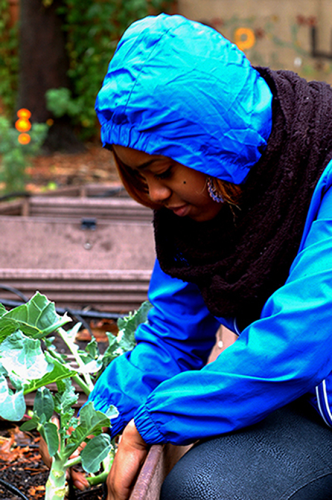Jun 19, 2013
Environmental scientist gets down to earth in soil mite studies
Environmental scientist gets down to earth in soil mite studies
Amanda Henderson never would have predicted her DePaul University studies would make her the census taker for a creature whose presence in the Lincoln Park community alone is estimated at more than 20 billion. But Henderson, who received a bachelor’s degree in environmental science this spring, did just that through research on the mite Oppiella nova and her development of a new system for extracting mites from soil.
Although Henderson knew she wanted to study soil, she hit the mother lode at the end of her sophomore year when her academic advisor, Liam Heneghan, professor of environmental science, asked her to assist in his research on soil species. From there, she was hooked.
“I was very fortunate when I was assigned Dr. Heneghan as an advisor,” said Henderson, a student in DePaul’s College of Science and Health.
Oppiella nova plays an important role in the decomposition of dead organic matter, creating byproducts that are vital for plant growth. “Plants would cease to exist without that dead matter broken down,” Henderson said. “It took a great deal of trial and error, but so far this method has been a reliable technique producing substantial results.”
During their research, Henderson developed a highly effective technique for rapidly removing the mites from soil samples to gauge their total population. Her technique, which significantly reduced processing time, involves removing small soil samples, roughly five centimeters square, and soaking them in kerosene, which causes the mites to float. Once the mites from the sample are tabulated, those numbers are extrapolated to get the population for a specific area of land. From her October 2012 sampling, Henderson estimated there are 22 billion Oppiella nova in the Lincoln Park community.
“The work this study is undertaking is intended to reveal the abundance and distribution of what we think may be the most common soil animal in Chicago,” noted Henderson.
Henderson describes her technique as “rather crooked and nonlinear.” She knew she would need numerous soil samples for the research, so citizen scientists were recruited. Two dozen members of the DePaul community participated in taking soil samples for the study. Henderson developed a self-service kit with instructions so participants would collect accurate soil samples.
With the ongoing support of her community, Henderson was able to continue her research and perfect her technique. “This was a tricky method to master, but it's something I'm very comfortable with now,” Henderson said.
After graduation, Henderson plans to continue her research and studies in graduate school. As for career plans, she is sure of one thing, “Whatever I do pursue, I will certainly maintain some connection to soil.”
Written by Ann Sherwood

Amanda Henderson, who graduated from DePaul with a bachelor’s degree in environmental science, pioneered a way for rapidly extracting mites from soil samples while pursuing her degree. (Photo courtesy of Amanda Henderson)
